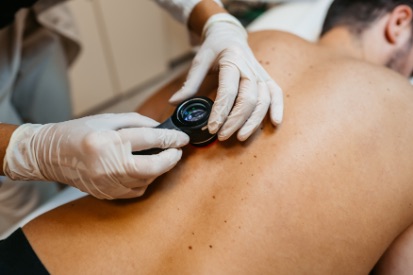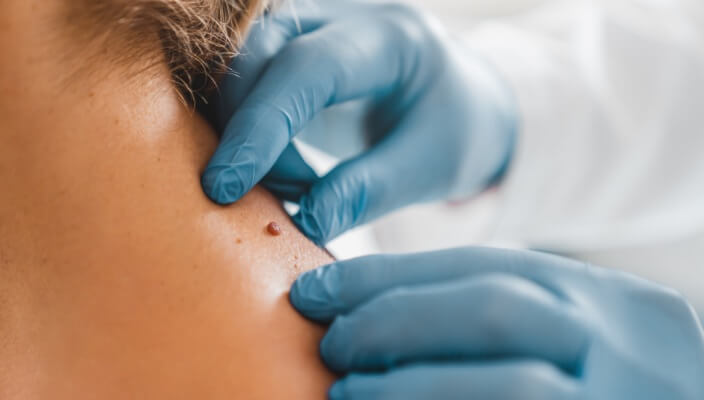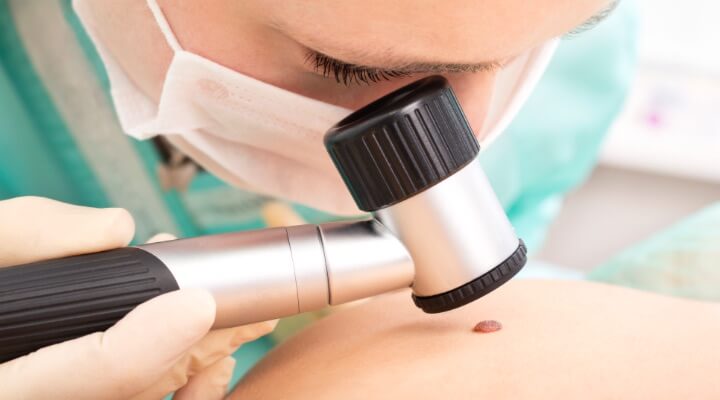Spotlight on Skin Cancer: Understanding Types, Risks, and Prevention
Learn About the 5 Types of Skin Cancer
 When was the last time that you examined your skin for signs of skin cancer? With skin cancer diagnoses becoming more and more common, it has never been more important to learn as much as you can about dangerous skin cancers, including what causes them and how they may show up on your skin.
When was the last time that you examined your skin for signs of skin cancer? With skin cancer diagnoses becoming more and more common, it has never been more important to learn as much as you can about dangerous skin cancers, including what causes them and how they may show up on your skin. In this blog, we’re covering what you need to know about five dangerous skin cancers, including basal cell carcinoma (BCC), squamous cell carcinoma (SCC), malignant melanoma, merkel cell carcinoma, and kaposi sarcoma.
Basal Cell Carcinoma (BCC)
An estimated 3.6 million Americans are diagnosed with BCC each year, making it the most common form of skin cancer diagnosed in the United States. Even more alarming is that more than one out of every three new cancers are skin cancers, and the vast majority are BCCs.
So what is basal cell carcinoma? This type of skin cancer begins in the basal cells, which are one of three main types of cells found in the epidermis (topmost layer of skin).
In many cases, basal cell carcinoma is caused by overexposure to UV rays, either from the sun or tanning beds. This UV ray exposure damages the cells and triggers uncontrolled cell growth, resulting in the development of a cancerous tumor or lesion.
BCC can take on many different forms. Typically, it shows up on the skin as a pearly nodule, sore that continuously heals and reopens, slightly-elevated pink growth, irritated patches of skin with a reddish color, or waxy-looking scar.
Squamous Cell Carcinoma (SCC)
According to the American Cancer Society, about two out of ten skin cancers are squamous cell carcinomas, making it the second most common skin cancer diagnosed in the United States.
This type of skin cancer starts in the squamous cells, which are flat cells located in the upper part of the epidermis. It most often appears on sun-exposed areas of the body, such as the face, ears, neck, lips, and backs of the hands, which is why squamous cell carcinoma is generally thought to be caused by excessive, unprotected exposure to ultraviolet rays.
Squamous cell carcinoma often looks like a crusted or scaly area of skin with a red, inflamed base that looks similar to a growing tumor, non-healing ulcer, or crusted-over patch of skin.
Melanoma
Though melanoma is the rarest of all skin cancers, and is far less common than BCC and SCC, it has a much higher chance of spreading into nearby tissue and other parts of the body, making it by far one of the most dangerous forms.
Melanoma begins in the melanocytes, the pigment-making cells found in the epidermis. When your skin is exposed to UV rays, this causes skin damage that triggers the melanocytes to produce more melanin. In some cases, This damage can cause mutations in the melanocytes, triggering them to grow out of control, resulting in melanoma skin cancer.
Melanoma can show up on the skin in many different shapes, sizes, and colors. To detect this dangerous skin cancer, our board-certified dermatologists use several different methods. Generally, if you notice a new, changing, or unusual mole or spot on your skin, visit a doctor immediately for a skin cancer screening.
Merkel Cell Carcinoma
Merkel cell carcinoma is a rare, dangerous form of skin cancer that presents a high risk of recurrence and spreading to other parts of the body. This type of cancer begins in the merkel cells located at the base of the top layer of the skin (the epidermis). These cells are connected to nerves, signaling touch sensation as “touch receptors.”
Though merkel cell carcinoma often shows up on sun-exposed skin, it can appear anywhere on the body. Merkel cell carcinomas often look like firm, pink, red, or purple lesions or bumps on the skin. In most cases, they aren’t painful, but they can grow rapidly and sometimes open up as ulcers or sores.
Kaposi Sarcoma
Another rare but dangerous skin cancer, kaposi sarcoma develops from the cells that line the blood vessels or lymph vessels. According to The Skin Cancer Foundation, this skin cancer is caused by the kaposi sarcoma-associated herpesvirus 8 (KSHV).
This type of skin cancer mostly affects men over age fifty of European, Mediterranean or Middle Eastern descent and individuals with weakened immune systems, including cancer patients, organ transplant recipients and people who are HIV positive.
The warning signs and symptoms of kaposi sarcoma vary, with it initially showing up as flat or slightly raised spots or lesions in the skin, mucous membranes, lymph nodes and other organs. These can be purple, brown, or red.

Schedule Your Skin Cancer Screening at Cumberland Skin
Early detection is the key to curing melanoma. If you notice a strange spot or suspicious mole on your skin, come see us right away. We’d also love to get your annual skin exam on the books!
Featured Products

iS Clinical Sheald Recovery Balm
SHEALD Recovery Balm is a moisture-rich formula that dramatically replenishes hydration to dry, sensitive, or compromised skin. This fortifying remedy works overtime to help support the skin’s function while soothing, curative botanicals relieve discomfort of dry, distressed, and post-procedure skin. Clinically proven to provide environmental protection. 60 g e Net wt. 2 oz.

SkinCeuticals Physical Fusion UV Defense SPF 50
Physical Fusion UV Defense SPF 50 is a tinted, fluid sunscreen that leaves a radiant, even finish. It offers broad spectrum UVA/UVB protection for all skin types, including sensitive, while boosting skin's natural defenses to environmental stress using artemia salina, a plankton extract. This sunscreen is water resistant for up to 40 minutes. 1.7 fl oz / 50 mL
Related Blog Posts

- Skin Cancer
- General Dermatology
- Skin Exams
- Sun Safety
If your dermatologist finds a suspicious mole during your TBSE, hey want to perform a skin biopsy.
Read More
- Skin Cancer
- Skin Exams
With skin cancer cases rising year after year, it’s no surprise that people are itching to learn more about this life-threatening skin disease
Read More
- Skin Cancer
- Skin Exams
It’s time to face the facts: skin cancer can develop in individuals of all skin colors, including those with darker skin tones.
Read More


